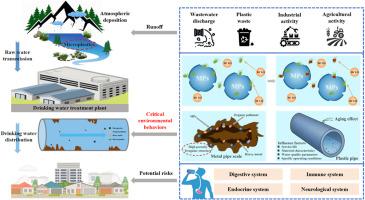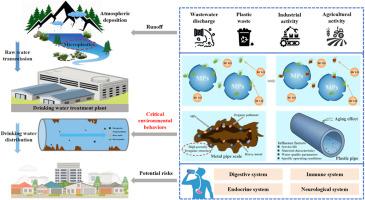Microplastics in drinking water distribution systems: Occurrence, environmental behavior, and human health concerns
IF 7.3
2区 环境科学与生态学
Q1 ENVIRONMENTAL SCIENCES
引用次数: 0
Abstract
Microplastics, increasingly detected in drinking water, have sparked growing concern due to their persistence, potential bioaccumulation, and risks to human health. Elucidating their fate in drinking water distribution systems (DWDSs) is critical for accurately assessing exposure risks and guiding effective mitigation strategies. This review systematically evaluates the microplastic occurrence at key nodes in DWDSs, their morphological characteristics, and environmental behaviors within the network. Direct comparisons across studies are hindered by methodological inconsistencies, highlighting the need for standardized protocols. Drinking water treatment plants serve vital function limiting microplastics ingress into the distribution systems, but conventional technologies often fail to ensure complete removal. Microplastics are predominantly present as small and fibrous particles within DWDSs. The wear and degradation of plastic pipes and fittings are recognized as potential sources of microplastic contamination. Neglected small microplastics and nanoplastics tend to exhibit colloidal properties that enhance their mobility and sorption potential. Microplastics exhibit complex environmental behaviors during transport. Due to their diminutive size and high specific surface area, microplastics act as effective vectors for microbial colonization and co-pollutant accumulation, thereby intensifying the composite contamination risk. Furthermore, the irregular structure and high porosity of the pipe scale facilitate microplastic retention and adsorption. This review reveals the distribution and fate of microplastics in DWDSs, offering scientific references for developing effective pollution control strategies for microplastics.


饮用水分配系统中的微塑料:发生、环境行为和人类健康问题
饮用水中越来越多地检测到微塑料,由于其持久性、潜在的生物蓄积性和对人类健康的风险,引起了越来越多的关注。阐明它们在饮用水分配系统中的命运对于准确评估暴露风险和指导有效的缓解战略至关重要。本文系统地评估了dwds关键节点的微塑性发生、形态特征和网络内的环境行为。研究之间的直接比较受到方法不一致的阻碍,这突出了标准化方案的必要性。饮用水处理厂在限制微塑料进入供水系统方面发挥着至关重要的作用,但传统技术往往无法确保完全去除微塑料。微塑料主要以小颗粒和纤维状颗粒存在于dwds中。塑料管道和配件的磨损和退化被认为是微塑料污染的潜在来源。被忽视的小微塑料和纳米塑料倾向于表现出增强其流动性和吸附潜力的胶体特性。微塑料在运输过程中表现出复杂的环境行为。微塑料由于体积小、比表面积高,成为微生物定植和共污染物积累的有效载体,从而加剧了复合污染风险。此外,管垢的不规则结构和高孔隙率有利于微塑料的保留和吸附。本文综述了微塑料在dwds中的分布和命运,为制定有效的微塑料污染控制策略提供科学参考。
本文章由计算机程序翻译,如有差异,请以英文原文为准。
求助全文
约1分钟内获得全文
求助全文
来源期刊

Environmental Pollution
环境科学-环境科学
CiteScore
16.00
自引率
6.70%
发文量
2082
审稿时长
2.9 months
期刊介绍:
Environmental Pollution is an international peer-reviewed journal that publishes high-quality research papers and review articles covering all aspects of environmental pollution and its impacts on ecosystems and human health.
Subject areas include, but are not limited to:
• Sources and occurrences of pollutants that are clearly defined and measured in environmental compartments, food and food-related items, and human bodies;
• Interlinks between contaminant exposure and biological, ecological, and human health effects, including those of climate change;
• Contaminants of emerging concerns (including but not limited to antibiotic resistant microorganisms or genes, microplastics/nanoplastics, electronic wastes, light, and noise) and/or their biological, ecological, or human health effects;
• Laboratory and field studies on the remediation/mitigation of environmental pollution via new techniques and with clear links to biological, ecological, or human health effects;
• Modeling of pollution processes, patterns, or trends that is of clear environmental and/or human health interest;
• New techniques that measure and examine environmental occurrences, transport, behavior, and effects of pollutants within the environment or the laboratory, provided that they can be clearly used to address problems within regional or global environmental compartments.
 求助内容:
求助内容: 应助结果提醒方式:
应助结果提醒方式:


